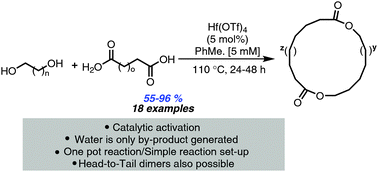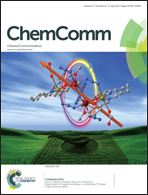Direct synthesis of macrodiolides via hafnium(iv) catalysis†
Abstract
Efficient direct synthesis of macrodiolides via catalysis using Hf(OTf)4 is possible in high yields, forming water as the sole by-product. The first protocol for the direct synthesis of macrodiolides from equimolar mixtures of diols and dicarboxylic acids was developed (58–96%). In addition, modification of the reaction concentration allows for the synthesis of head-to-tail macrodiolides from the corresponding seco acids. The catalytic preparation of the macrodiolides using a commercially available catalyst without the need for slow addition or azeotropic condition provides an operationally simple alternative to protocols which employ toxic tin catalysts or stoichiometric activation strategies.


 Please wait while we load your content...
Please wait while we load your content...